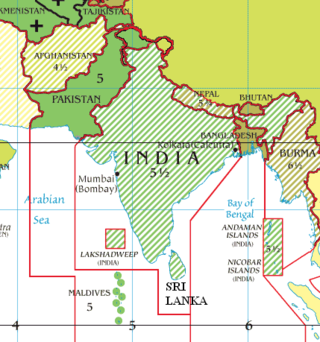
A time zone is an area which observes a uniform standard time for legal, commercial and social purposes. Time zones tend to follow the boundaries between countries and their subdivisions instead of strictly following longitude, because it is convenient for areas in frequent communication to keep the same time.

Indian Standard Time (IST), sometimes also called India Standard Time, is the time zone observed throughout the Republic of India, with a time offset of UTC+05:30. India does not observe daylight saving time or other seasonal adjustments. In military and aviation time, IST is designated E* ("Echo-Star"). It is indicated as Asia/Kolkata in the IANA time zone database.

Summer time in Europe is the variation of standard clock time that is applied in most European countries in the period between spring and autumn, during which clocks are advanced by one hour from the time observed in the rest of the year, with a view to making the most efficient use of seasonal daylight. It corresponds to the notion and practice of daylight saving time (DST) to be found in some other parts of the world.

Eastern European Time (EET) is one of the names of UTC+02:00 time zone, 2 hours ahead of Coordinated Universal Time. The zone uses daylight saving time, so that it uses UTC+03:00 during the summer.

Moscow Time is the time zone for the city of Moscow, Russia, and most of western Russia, including Saint Petersburg. It is the second-westernmost of the eleven time zones of Russia. It has been set to UTC+03:00 without DST since 26 October 2014; before that date it had been set to UTC+04:00 year-round on 27 March 2011.

UTC+08:00 is an identifier for a time offset from UTC of +08:00.

UTC+03:00 is an identifier for a time offset from UTC of +03:00. In areas using this time offset, the time is three hours later than the Coordinated Universal Time (UTC). Following the ISO 8601 standard, a time with this offset would be written as, for example, 2019-02-08T23:36:06+03:00.

UTC+05:00 is an identifier for a time offset from UTC of +05:00. This time is used in:

Australia uses three main time zones: Australian Eastern Standard Time, Australian Central Standard Time and Australian Western Standard Time.

Pakistan Standard Time is UTC+05:00 hours ahead of Coordinated Universal Time. The time zone is in use during standard time in Asia.

Omsk Time (OMST) is a time zone in Russia that is six hours ahead of UTC (UTC+06:00), and 3 hours ahead of Moscow Time (MSK). It is used in Omsk Oblast.

There are eleven time zones in Russia, which currently observe times ranging from UTC+02:00 to UTC+12:00. Daylight saving time (DST) has not been used in Russia since 26 October 2014. From 27 March 2011 to 26 October 2014, permanent DST was used.

Central Africa Time or CAT, is a time zone used in central and southern Africa. Central Africa Time is two hours ahead of Coordinated Universal Time (UTC+02:00), which is the same as the adjacent South Africa Standard Time, Egypt Standard Time, Eastern European Time, Kaliningrad Time and Central European Summer Time.

East Africa Time, or EAT, is a time zone used in eastern Africa. The time zone is three hours ahead of UTC (UTC+03:00), which is the same as Moscow Time, Arabia Standard Time, Further-eastern European Time and Eastern European Summer Time.

Azerbaijan Time, abbreviated as AZT, is the standard time zone in Azerbaijan, four hours ahead of UTC (UTC+04:00). The daylight saving time adjustment, Azerbaijan Summer Time (AZST), was one hour ahead at UTC+05:00 and was introduced in 1997 and discontinued in March 2016.

Irkutsk Time (IRKT) is the time zone eight hours ahead of UTC (UTC+08:00) and 5 hours ahead of Moscow Time (MSK+5).

Yakutsk Time (YAKT) is a time zone in Russia which is nine hours ahead of GMT, and six hours ahead of Moscow Time (MSK).

Vladivostok Time (VLAT), is a time zone in Russia, named after the city of Vladivostok. It is ten hours ahead of UTC (UTC+10:00) and seven hours ahead of Moscow Time (MSK+7).

Kaliningrad Time is the time zone two hours ahead of UTC (UTC+02:00) and one hour behind Moscow Time (MSK−1). It is used in Kaliningrad Oblast.

As of 2022, daylight saving time is used in the following Asian countries:












